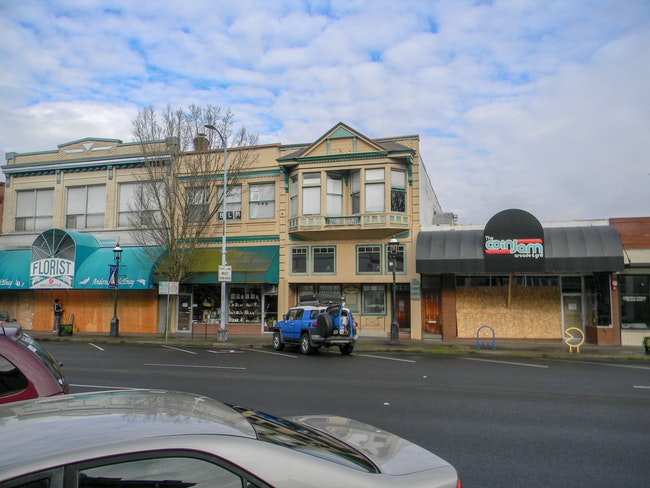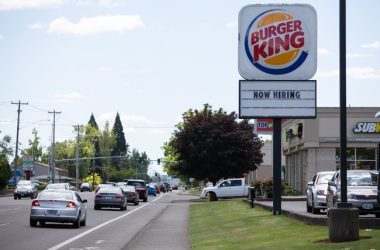
Businesses remain boarded up in downtown Salem following unrest in January. (Jake Thomas/Salem Reporter)
When a federal program designed to keep workers on the payroll amid the pandemic launched last spring, CJ Nelson, the owner of Salem’s The Coin Jam, recalled being apprehensive about applying for money that had strings attached.
The Paycheck Protection Program was part of the pandemic relief package passed by Congress in March of last year. It offered forgivable loans to businesses if they kept workers on the payroll while pandemic restrictions put clamps on the economy. The program was so popular that it exhausted the initial $349 billion allocated to it within weeks of launching in April.
After Congress approved additional funding in July, Nelson secured a loan under the program for his downtown “barcade” where for the last seven years customers gathered to eat tacos and drink beers in between rounds of air hockey and retro arcade games.
“I would say it gave me a shot to stay around,” said Nelson, who was motivated to apply for the loan after seeing the L.A. Lakers and other large companies qualify for loans. But said it didn’t make his business suddenly profitable, adding, “It just kind of turned the losses from a waterfall into a drip.”
Last month, the federal government again opened the floodgates for the Paycheck Protection Program. Like the last version of the program, businesses that use the money for payroll and other eligible expenses – including rent and utilities – can apply to have the loan forgiven. But this time it has features intended to steer cash towards small business owners who have struggled under the downturn.
Despite the infusion of cash, business owners like Nelson don’t have a clear picture of what the economy will look like when the money runs out.
According to the most recent numbers from the U.S. Small Business Administration released on Monday, a total of 22,340 companies in Oregon have received loans totaling $1.9 billion since the program reopened on Jan. 11.
The data is released in two sets: businesses that received loans worth up to $150,000 and those that received larger loans. So far, 82 Salem businesses have received loans over the $150,000 threshold, totaling $35 million, with the median loan worth $259,694.
Fourteen of those loans went to businesses classified as full-service restaurants, which have been hard-hit by the pandemic, more than any other category. Medical offices, construction companies and others made up the rest. Also included was Capitol Racquet Sports Inc., a Salem gym that operates under the name Courthouse Club Fitness and has received nearly a quarter-million dollars in state fines for defying pandemic restrictions.
Records show the company was approved in January for a $1 million loan. John Miller, the company’s president, didn’t respond to a phone call Monday seeking comment.
Another 454 Salem businesses received loans individually worth up to $150,000, totaling $21 million with the median loan worth $31,343. Of these, 38 went to businesses classified as full-service restaurants, more than any other category.
“Nobody is going to be making money,” said Nelson, who received another loan under the program. “You are going to be losing it at a slower rate.”
The earlier loan (Nelson wouldn’t say how much, but federal data show it was under $150,000) helped The Coin Jam reopen over the summer as Covid restrictions were relaxed. Nelson said the money ran out in November just as Gov. Kate Brown enacted a new set of restrictions on bars, restaurants and other businesses in response to spiking Covid transmissions. He’s remained closed since.
Last year, the program drew criticism that the money went to large publicly-traded companies. In December, The Oregonian/OregonLive reported that just a sliver of companies, including McMenamins and Pendleton Woolen Mills, accounted for most of the loans made in Oregon.
Ryan Dempster, president and CEO of Willamette Valley Bank, said in an email that the program was first launched when the pandemic’s economic impact was uncertain. He said the big difference in this version of the program is companies have to demonstrate they’ve experienced a decline in revenue of 25% of more in one quarter of 2020 compared to the same quarter in 2019.
“This criteria has limited the demand for the funds to businesses who have been impacted most by the pandemic and need the funds to sustain their operations until restrictions lapse and allow them to return to normal operating conditions,” he said.
The relaunched program includes other measures intended to direct the money to small businesses. Those measures include giving financial institutions with less than $1 billion in assets priority with the expectation they’d make loans to small businesses in their communities.
Dempster said the changes to the program are working, pointing to federal data released last week showing that the average loan size under the Paycheck Protection Programs second draw is $75,000 and 70% of loans were $50,000 or less.
He said overall the program has worked, allowing businesses to stay open and retain employees after seeing a drop in revenue. The revived program will continue to help businesses that have reduced businesses as much as possible but are still struggling.
Nelson, owner of The Coin Jam, said he was expecting a new round of pandemic restrictions when bars and restaurants were closed in November and didn’t have as much food on hand. This time, he also unplugged the older arcade games, such as Asteroid and Donkey Kong, instead of leaving them on, which he said some say helps the machines run better. This time, he’s not sure when he’ll be allowed to reopen or when another shutdown order could come. His 19 employees remain in limbo.
“Who knows?” he said “You’re just kind of playing the guessing game.”
Conrad Venti, the owner of Venti’s Cafe, said in an email that this version of the program gives businesses 24 weeks, instead of eight, to use the funds. He said that’s a big help to his business, which received a $368,000 loan in January, with so much uncertainty remaining. Currently, Marion County restaurants are not allowed to offer indoor dining, a situation Venti hopes will change soon.
“The longer we are not using our indoor space the quicker we’ll use the funds up,” he said. “Outdoor dining and takeout only in Oregon simply do not work for restaurants.”
Laura Tesler, board president of the Salem Art Association, said her group is facing a second year where the annual Salem Art Fair is going to be canceled. The nonprofit has also seen revenue decline with galleries being closed and is operating with a “skeleton crew.” The nonprofit received a $102,207 loan with the hopes that events will be allowed next year.
“We are just trying to keep the door open,” she said.
Jon Thompson, an associate professor of economics at Willamette University, said that it appears that changes to the program are getting money to smaller businesses. But he said businesses will continue to face uncertainty knowing the program will end and it should have been structured to wind down as the pandemic subsides.
“Uncertainty is really costly,” he said. “Entrepreneurs don’t invest. They don’t hire.”
Contact reporter Jake Thomas at 503-575-1251 or [email protected] or @jakethomas2009.
WE GET SALEM THE FACTS. Covering your community with care and depth. Salem Reporter – fair, accurate, independent. Subscribe and support our essential local service.









